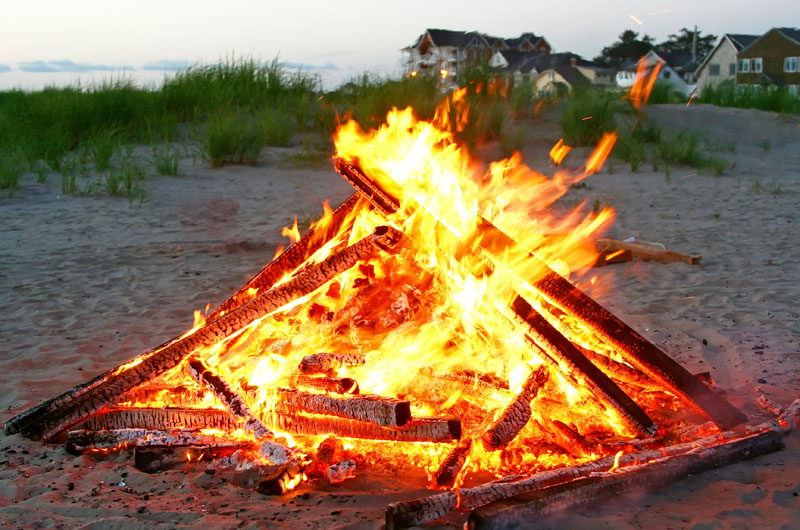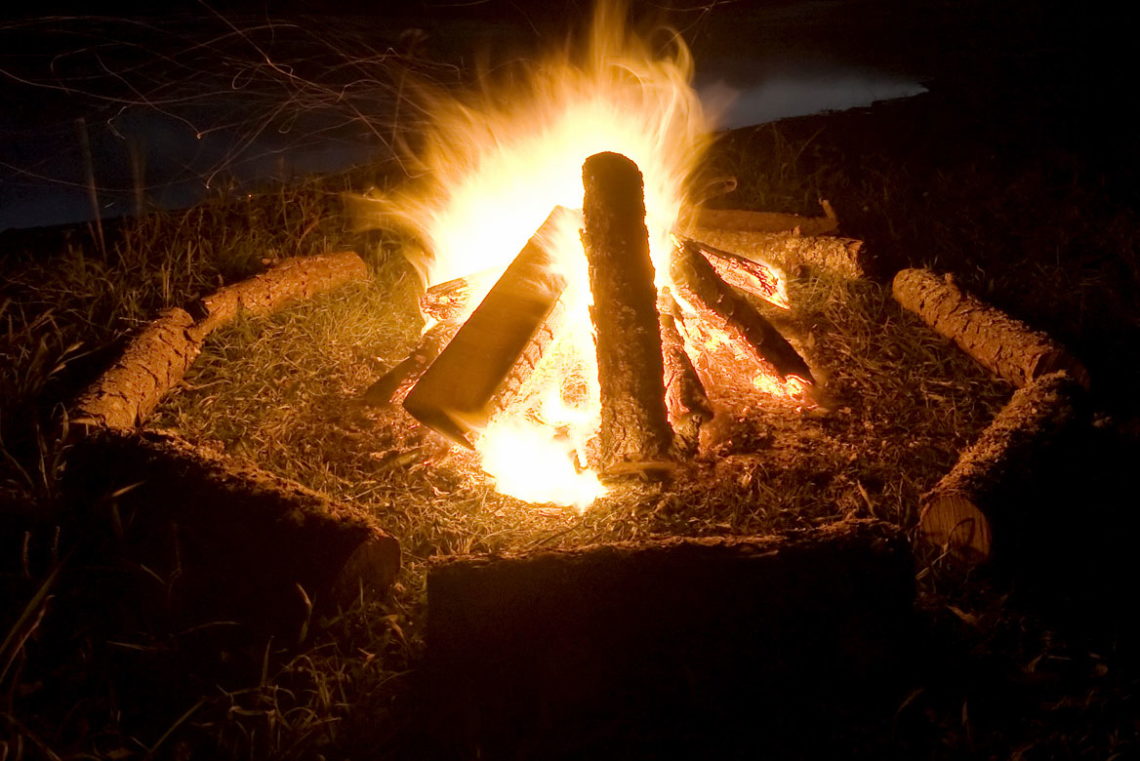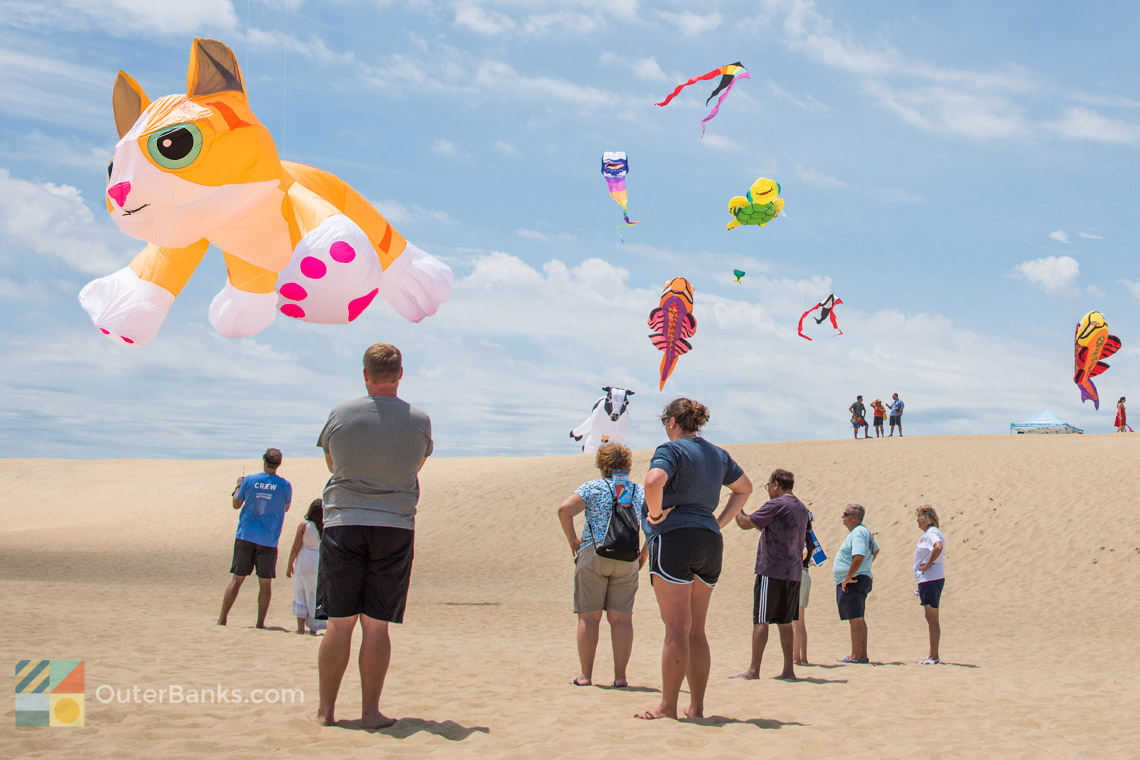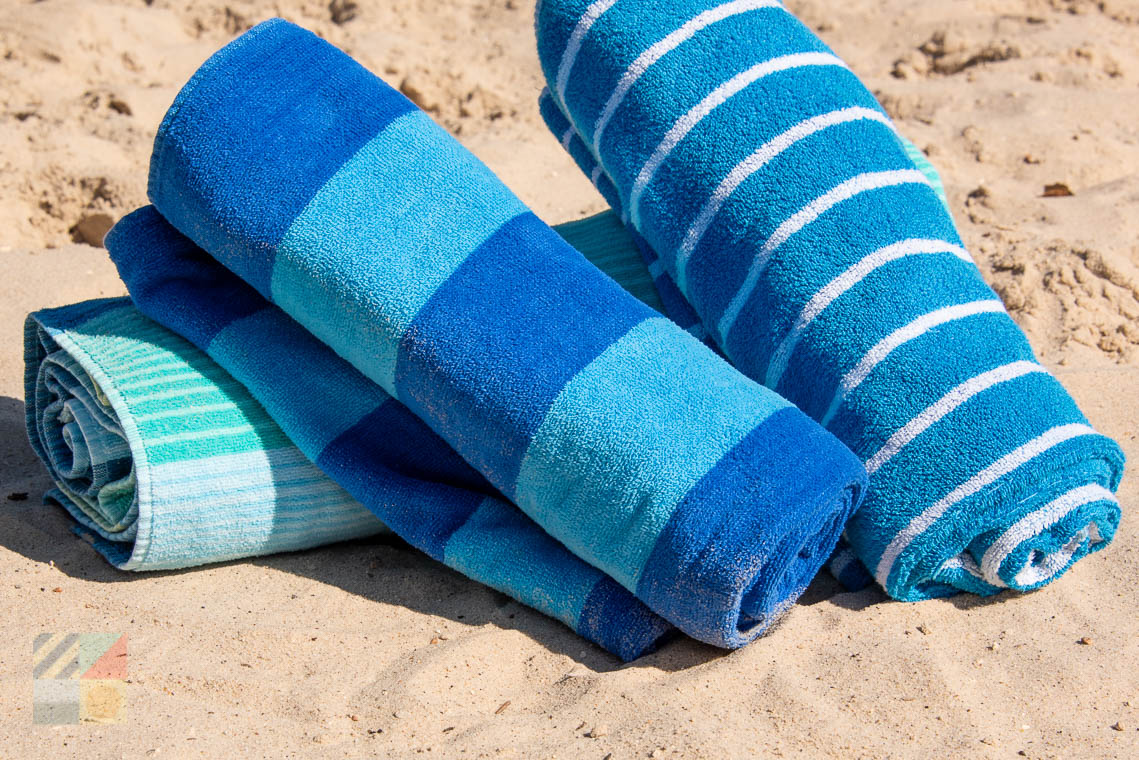Outer Banks Bonfire Regulations
- Corolla, Duck, Southern Shores, Kitty Hawk, and Kill Devil Hills - Bonfires are not permitted on the beach.
- Nags Head - Bonfires are allowed on the beach with a permit. Permits are issued by Nags Head Fire and Rescue online here. Permits are based on current wind and fire danger conditions.
- Rodanthe, Waves, Salvo, Avon, Buxton, Frisco, Hatteras, and Ocracoke (Cape Hatteras National Seashore oversees these beaches) - Beach fire permits are required. Print, sign and keep your paper permit with you (permits available here)From May 1 to November 15, beach bonfires are only allowed at Coquina Beach, the villages of Rodanthe, Waves, Salvo, Avon, Buxton, Frisco and Hatteras, and the Ocracoke day use area. From November 16 - April 30, Beach fires are allowed throughout the park. Fires are allowed from 6am - 10pm. An adult must be present. Fires must not be greater than 3 feet in diameter. Fires must be built and maintained below the high-tide line and 50 feet from any vegetation. Fires cannot be left unattended, and must be extinguished upon end of use. The area must be cleaned up.

For many vacationers, having a bonfire or a fire pit on the beach is a family tradition that begins a weeklong stay at the shore, caps off the end of a great vacation, or just provides a little budget-friendly entertainment on an otherwise quiet Tuesday night.
The great draw about the Outer Banks is that there are literally miles of shoreline where beach fires are permissible, provided that beach-goers follow the local, (or in some cases national) rules, and use a little common sense. Easy to do, accessible to most all southern Outer Banks families, and an entertaining way to enjoy the wild nightlife, a beach bonfire should definitely be at the top of your night owl activity agenda.
Frequently Asked Questions
Can you have a beach bonfire on the Outer Banks?
Beach bonfires are allowed in certain areas of the Outer Banks including the Cape Hatteras National Seashore on Hatteras and Ocracoke Islands, and the town of Nags Head. As a rule of thumb, fires must be below the high tide line and must be manned at all times. Fires should be completely extinguished before leaving the beach.
Where can you buy firewood on the Outer Banks?
Firewood for beach bonfires is available at many major grocery stores and convenience stores throughout the Outer Banks where beach fires are allowed.
Do you need a permit for a beach bonfires on the Outer Banks?
A permit is required to have a beach bonfire in the town of Nags Head, as well as on Hatteras and Ocracoke Islands.
Are beach bonfires allowed on Hatteras Island?
Beach bonfires are permitted within the Cape Hatteras National Seashore. Fires must be below the high tide line, and must be located a minimum of 100 feet from dune vegetation. All fires must be attended by an adult, and completely put out with water before leaving the area. A permit is required, and can be obtained via the Cape Hatteras National Seashore’s website.
Are beach bonfires allowed on Ocracoke Island?
Beach bonfires are allowed on Ocracoke Island beaches, provided that beachgoers obtain a permit from the National Park Service. Permits for bonfires can be obtained in person or online. Fires must be established below the high tide line, and must be fully extinguished before leaving the site. Fires are allowed from 6 a.m. until 10 p.m.
Are beach bonfires allowed in Corolla?
Beach bonfires are not allowed in the town of Corolla, or the northern 4WD area beaches of Carova.
Are beach bonfires allowed in Nags Head?
Beach bonfires are permitted in the town of Nags Head with a permit. Permits are issued between 5 p.m. and 9 p.m. daily and can be obtained at one of the town’s two fire stations, or online at the Town of Nags Head’s website. There is a small fee to obtain a permit for a beach bonfire.
Where can you get a beach bonfire permit in Nags Head?
Beach bonfire permits in the town of Nags Head are issued by the local fire department. They can be picked up daily from 5 p.m. until 9 p.m. at the town’s two fire stations, (located at mileposts 15 or 18), or can be downloaded online.
Are beach bonfires allowed all year long on the Outer Banks?
Beach fires are permitted all year long in Outer Banks towns and areas where bonfires are allowed. There may be restrictions on bonfires during special circumstances, such as area-wide droughts, sea turtle nesting, or very windy weather.
Starting and maintaining a beach bonfire
Well before you strike a match, you'll want to make sure that your bonfire site is prepped and ready to go. The first order of business is picking a spot. On occasion, other families may leave up tents or canopies overnight, (though in some areas the practice is frowned upon.) Nevertheless, be sure and pick a spot that is well away from anything flammable, including temporary canopies, volleyball nets, and sea oats or other grasses.
The next step of site scouting is to look for the high tide line. You'll want to make sure that your fire is below this line in the sand, as in most areas it is a local law because it greatly reduces the threat of the fire spreading off the beach. To spot the high tide line, look for an area of beach that is lined with clusters of sea grass, and devoid of thousands of footprints. Because the area is literally wiped clean every day from the ocean, only a handful of footprints are generally visible during any given time of day.
With this in mind, you'll also want to check on the local tide charts, which are available online via a number of local and national sites, (including the NOAA's site), or you can pick up a free tide chart booklet at your local tackle shop. Aim for an evening when the low tide is generally within 2-3 hours of when you're planning to have your bonfire, as this will ensure your fire doesn't have an abrupt end with an incoming high tide. If low tide is at an inconvenient time, like 6:00 in the evening, not to worry - the tides generally shift an hour ahead daily, so in just two days' time, low tide will be at 8:00 p.m. instead.
One you have your locale picked out, it's time to start digging. A shovel will come in handy, although a few sturdy beach buckets will certainly work in a pinch. You'll want a nice wide area that runs about 2-3' feet deep, depending on the wind speed. If it's an exceptionally breezy day, the further you dig, the more protected your fire will be from the wind.
Next, it's time to build the base of your fire. While everyone has their own method, the most popular strategy among locals and seasoned vacationers is to use a mixture of a few heavy duty logs, some smaller pieces of scrap wood, and some balled up bunches of newspaper. Set your heaviest logs in the middle, with a few scrap pieces and newspapers tucked in between the cracks, under the pile, and generally mixed in throughout. By having your easier-to-burn material spaced throughout the larger logs, it will help those big pieces catch fire quickly, and once established, will burn throughout the fire pit instead of in just one concentrated area.
Try to do this preliminary scouting, digging and prep work in the evening while the sun is still barely out, as it's much easier to do with a little daylight than with a flashlight.
One of the biggest questions for newcomers is where on earth to get firewood on a beach. The answer is just about anywhere. The majority of local grocery stores, hardware stores, and convenience stores, especially on Hatteras and Ocracoke Islands, sell small bundles of firewood that are easy to carry, and are just the right amount of wood for a beach bonfire. While on the Cape Hatteras National Seashore you might find scraps of driftwood or small dry pieces of scrap wood along the beach to act as filler, resist the urge to scout around a neighboring construction site or vacant lot. Of course, extensive planners can also bring a little bit of firewood from home to save a few bucks, and for scrap pieces, a short walk through Buxton or Frisco woods might yield a nice supply of dry sticks and twigs to throw in.
Once you have your fire ready to go, be sure and bring some comfy chairs, a cooler, and anything else you'll need for a lazy night of lounging at the beach. In the shoulder and off-seasons, the nighttime temperatures can drop a good 10 degrees or even more from the peak daytime temperatures, so you may want to bring along a sweatshirt and hooded jacket as well, especially on windy nights when a cool breeze can be a little chilly on the face and the ears.
Many locals try to avoid lighter fluid when trying to get that first spark going, as often a soaking of lighter fluid just burns up the smaller materials faster without catching the larger logs and blocks of wood on fire. A good way to start your fire sans lighter fluid is to slowly light the edges of a few of your newspapers, let them burn, and then repeat as needed if they don't catch right away. It may take a few minutes for the fire to get up to full-blast, but once it's going, a well-stacked wood pile will last for several hours of fireside entertainment.
Tips and Tricks for Beach Bonfires
- Make sure you bring the flashlights along. Not only do they come in handy for those first few minutes of starting the fire, but with a flashlight in hand, young family members with busy feet can go explore the beach at night, and always be within sight of the fire. Send the kids off to look for ghost crabs, find small pieces of wood on the beach, or load up some buckets of water, and with all the energy they expend at night, they're sure to have a great night's sleep.
- Always bring a little more wood than you think you'll need. It never hurts to have a couple extra logs for an extended bonfire celebration, or a few armfuls of newspapers or scrap wood pieces to pile onto a fire that's having a hard time igniting. Besides, it's much easier to bring extra than to make multiple runs back and forth to the beach house.
- To add an extra glow to an already fun nighttime activity, aim for certain days and locales. A full moon on the Outer Banks is absolutely stunning, with an extra glow over the ocean and the shoreline. A completely clear night is also a fantastic time to go, as the stars on the beach fold over the shoreline like a canopy, and shine brightly in every direction. Finally, lighthouse lovers may want to scout out a spot in Avon or Buxton, where the distant light of the Cape Hatteras lighthouse can be seen flashing along the shoreline every 7 seconds at nighttime. While certainly anytime is a good time for a beach bonfire, adding an extra elements of natural attractions certainly doesn't hurt, and adds an extra "wow" factor to the experience.
- If you venture from the fire to take a stroll along the beach, dip your toes in the wet sand and look for the shimmering, almost green glowing tracks that are made in the process. These glowing trails are actually a small sea critter called the dinoflagellate, which is a tiny, single-celled organism that only comes out on particularly warm nights, and is best viewed during especially dark beach conditions.
- Be sure and check with the National Park Service (NPS)or local fire station to confirm that bonfires are permitted. On occasion, the NPS or town puts a temporary ban on beach bonfires during periods of extensive drought or wind. Best to check ahead of time to ensure your beach bonfire isn't a safety or fire hazard
- Not up to lugging all the firewood with you to the beach? Consider having a bonfire at one of the 4WD accessible beaches on Hatteras and Ocracoke Islands. This way, you can simply load up the truck with all your wood, chairs, and family members, and head to the beach with no excess hauling involved. The beach on the Cape Hatteras National Seashore is open to vehicles well into the evening, and is open for all night driving in the shoulder and winter seasons.
- While a beach bonfire may not be permitted in all regions of the Outer Banks, the good news is that a gorgeous beach that does allow bonfires is generally just a quick drive away. Hop in the car, and look for public parking areas along the Cape Hatteras National Seashore on NC Highway 12, and in Nags Head along the Beach Road for easy access to the shoreline. The best news is that these areas are usually uncrowded if not completely deserted after dark, which means that regardless of how crowded a beach is during the day, at night you'll have the sand all to yourself.
There's a good reason why beach bonfires have a tendency to pop up all along the shoreline after dark during the busy summer season. A bonfire can be a romantic evening just for two, an impromptu celebration for friends, or a family get-together that is sure to create some of your best memories on the beach.
With miles of beaches to choose from, and miles of stars overhead, a beach bonfire is an ideal activity to get the full experience of the Outer Banks beaches, both day and night. Grab the kids, the grandparents, and anyone else who loves a good story told by a cozy fire, and hit the beach for some completely wild nightlife, Outer Banks style.
-
OBX Wedding Fest
January 16th, 2026 - January 18th, 2026 -
Hatteras Island Oyster Roast
February 7th, 2026 1:00 PM - 4:00 PM -
First Friday in Manteo
March 6th, 2026 6:00 PM - 8:00 PM
Over 450 Outer Banks vacation rentals with amenities such as private pools, hot tubs, elevators, keyless entry, 1 - 9 bedrooms, Oceanfront to Soundfront, 4x4 Carova...
If you're planning a relaxing day on the beach, a great beach blanket is a must-have piece of gear. We've curated a list of highly-rated beach blankets, each selected for its unique features, quality, and durability. From lightweight, compact...
With the best views around and the quickest access to dolphins, Paradise Dolphin Cruises is committed to offering you one of the most amazing experiences of your life! Climb aboard the Kokomo, our 40-passenger catarmaran and the area’s newest...
We love to highlight some of the best and most interesting Outer Banks restaurants, shops, attractions and activities. Read on to discover some of our favorites!





